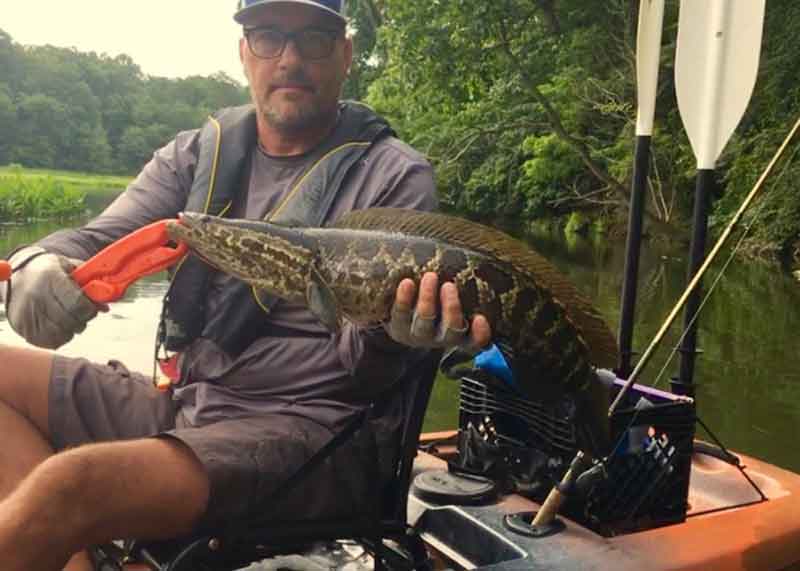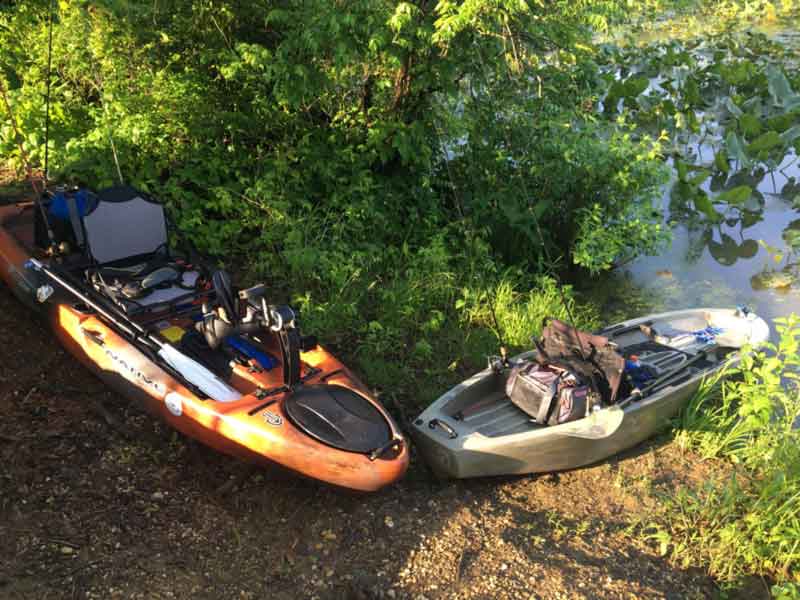I cast my Whopper Plopper under an overhanging tree, take a few turns on the reel, and the water erupts. My heart races – is it a largemouth bass or my target prey? Diving deep and pulling hard, I think it’s a snakehead. The fish takes a turn towards me. I reel faster, but it beats me and makes it under my kayak. The rod is bent, the tip touching the water. Can I pull him out from under the boat before he breaks me off? I reach for the net as the fish attempts to take another run, but I now have him on less than six feet of line. I can see his color, lift the rod tip, and dip my net under the snakehead. Got him! Or do I?

It’s June 18th and a little after 4 p.m. on this nice summer day, when I capture this particular snakehead. I’m sitting on my kayak at Mallows Bay just off the Potomac River in Charles County, Maryland. I place the net between my legs and gaze at my prize. Now I have to untangle the bait’s front treble from the net. I reach out and in an instant the fish loses its mind, thrashing about – and I suddenly feel pain in the index and middle fingers of my left hand. Now I’m hooked to the fish, as it continues on its insane thrashing. I reach under the net to find my pliers and unhook the fish. Now all I need to do is remove two buried hooks from my fingers. Yay. But it could be worse; a side note here, I have replaced all of my hard bait’s treble hooks with single inline hooks for this very reason. It’s safer for me, and for the fish I release, too.
Fishing for snakeheads can be a challenge, as some days they are on fire and others it’s as if they don’t exist at all. But this article isn’t about catching snakehead, it’s about being prepared and knowing what to do once they are in the kayak. As they say, you haven’t really caught a snakehead until it’s locked inside the cooler.
Part of how you’ll deal with a snakehead in the boat depends on your kayak. I use two different type of kayaks. Both are sit-on-tops and are built for fishing, but one is a paddle and other is a pedal type. They both have their advantages. The pedal kayak lets me move my hands free thereby allowing me to keep fishing and keep my bait in the water even when maneuvering or moving. I can cover more water quickly and with less effort. But when I need to get into really skinny water I need to retract the pedal system and change up to paddling, and now I have the pedal system on the deck and in my way. That can make landing and controlling a crazed, recently-netted snakehead more of a challenge. So if I’m fishing the open water of Blackwater or Mattawoman Creek I will use the pedal kayak, but if I’m fishing the shallows of Mallows bay or up a feeder creek to the Blackwater, I’ll leave the pedal system back home or simply take the paddle kayak.

Now let’s talk about gear. You’ll need a net, preferably with a handle on the shorter side. This makes it easier to stow and keep out of the way while fishing. But you’ll need a handle that’s long enough to reach the fish if you’re standing on your kayak. Keep in mind here, once you have the fish in the net, it really doesn’t want to stay in your net. I’ve had a 24-inch fish in my net jump clear out of it by a good 12-inches, land on the deck, and flip over the gunwale (again, until a snake is in the cooler it hasn’t really been “caught”). So once I have the fish in the net I do everything I can to prevent it from escaping, like getting a pair of fish-grips secured.
Once you have the snakehead under control (which you actually never really do) you can hold it by the grip. Helpful tip here, please do not use the fish grip without first placing your hand through the grip’s strap. I’ve seen fishermen drop fish and watch them swim away with the grip in their mouths. I prefer to use a plastic grip to the narrower metal type, because I’ve found that snakeheads, due to their incessant thrashing, will split their lower jaw with the metal grip. If you plan on releasing the fish use the wider-jaw plastic type or don’t use a grip at all.
I also carry good pairs of pliers and forceps, which you’ll need to remove your hook from the fish’s mouth. Of all the snakehead I’ve caught, 99-percent of them have the bait deep in their mouths. If you’re not prepared to behead them to get your hook back then you’ll need the tools to remove it.
For stowing my grips, pliers, scissors, and forceps, I have side pockets attached to the gunwale. I don’t keep my baits or any equipment on the deck of the kayak while fishing for snakehead, and I believe this is the most important point if you are to take anything away from this article – keep everything stowed away and in its place. Snakehead are aggressive, strong, slimy and unpredictable. All we can do is control our end of the battle, so be prepared and don’t clutter the deck of your kayak with things that can tangle lines or nets, or cause injury if they go flying. Store all of your gear away but where it’s readily accessible, when needed.
And believe me, you don’t want to have the hooks of a lure attached to a snakehead and one of your body parts, at the same time.
-By Eric Packard